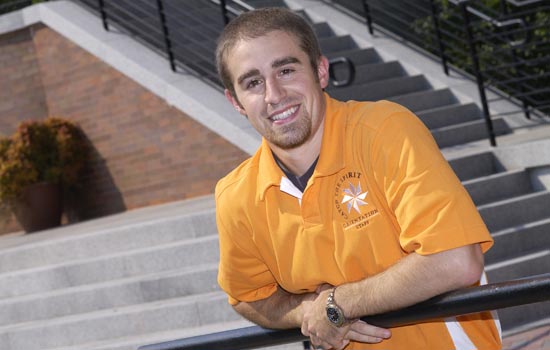Orientation volunteer brings spirit of community to campus
A. Sue Weisler | photographer
For three years, Stephen Baker has been a welcome face to incoming students and their families as a member of the New-Student Orientation team.
Stephen Baker enjoys the spirit that comes with being part of a community. For him, it all begins with family. “My mother is actually one of eight kids,” he explains, “and she made sure I knew my family—all my family—from when I was born.” Regular interaction with grandparents, aunts, uncles and cousins—including vacations and a yearly family reunion—became an important part of his upbringing. “Having that sense of community, and looking back on it, makes me really want to express it and show other people that same sense of community.” Soon after arriving at RIT from Butler, Pa., Baker looked for opportunities to engage the campus community.
Through a roommate, he became acquainted with RIT’s New-Student Orientation team. “They’re really a great group of people, and it inspired me to work for them and see what I could do.” Baker, a physics major in the College of Science, just completed his third year as an orientation assistant, serving the past two years in a leadership role. More than 100 upperclassmen are chosen annually to serve as OAs through a competitive recruitment process.
They help staff members plan, implement and evaluate aspects of the orientation program. Most importantly, OAs help new students transition into life at RIT. Baker says the opportunity that offers to serve as a mentor is particularly rewarding. “We get to see incoming students before anyone else is here,” he states. “We get to meet them all—start to associate names and faces. It’s really a great experience to meet them and interact with them.” Baker’s favorite part of orientation is move-in day, which he calls “ridiculous, yet unbelievably rewarding.” Orientation assistants work up to 12 hours that day. While their primary focus is helping new students get settled, there is also a chance to lend some reassurance to parents. “They are overwhelmed with information, but I think they get a sense of relief when they see a smiling face and see someone who’s there not necessarily to take care of their students, but to help them out so that it’s a smooth transition into college.” As the school year gets underway, Baker transitions to activities related to academics and other aspects of college life.
He serves as vice president of the College of Science Student Advisory Board, treasurer of the Society of Physics Students, and teaching assistant. In addition, Baker is active in undergraduate research, previously working with associate professor George Thurston to study the physics of eye lens proteins in relation to cataract disease. “Steve’s been a great asset to our laboratory,” states Thurston. “He is well-organized and gets things done, and he learned a lot of techniques and physics very quickly.” That experience helped Baker secure a summer job with NASA. Last month, he returned from Pasadena, Calif., where he worked at the agency’s Jet Propulsion Laboratory studying the impact of atmospheric aerosols on climate changes.
Now, with graduation in sight for next May, Baker’s focus turns to graduate school. His long-term plan is to pursue a doctorate in physics in hopes of one day teaching at a university—no doubt resuming a familiar role as mentor and community builder. “I think it comes from having that influence at home with my mother, not necessarily pounding it into me, but helping me to know how important that is.”










